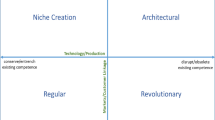Abstract
The basic science and technology research enterprise of the United States—sources of funding, performing institutions, researcher incentives and motivations—is reasonably well understood by academics and policy makers alike. Similarly corporate motivations, governance, finance, strategy, and competitive advantage have been much studied and are relatively well understood. But the process by which a technical idea of possible commercial value is converted into one or more commercially successful products—the transition from invention to innovation—is highly complex, poorly documented, and little studied. In this paper we discuss the process by which basic research is converted into successful commercial innovations. Following Arrow (1962) and Zeckhauser (1996), we explore the hypothesis that asymmetries of informaion and motivation, as well as institutional “gaps,” may systematically deter private investment into early stage technology development. We describe the role of governments—federal and state (or provincial)—in promoting the commercial transition from an invention to an innovation. We conclude by suggesting some lessons that may be learned from the experience of the Advanced Technology Program (ATP) of the United States Department of Commerce, among the few Federal programs specifically intended to meet this need.
Similar content being viewed by others
References
Aghion, P., N. Bloom, R. Blundell, R. Griffith, and P. Howitt, 2002, ‘Competition and Innovation: An Inverted U Relationship,’ unpublished manuscript.
Arrow, K.J., 1962, ‘Economic Welfare and the Allocation of Resources from Invention,’ in The Rate and Direction of Inventive Activity: Economic and Social Factors, Princeton, NJ: Princeton University Press.
Auerswald, P.E. and L.M. Branscomb, 2003, ‘Start-ups and Spin-offs: The Role of the Entrepreneur in Technology-Based Innovation,’ in David Hart (ed.), The Emergence of Entrepreneurship Policy: Governance, Start-Ups, and Growth in the Knowledge Economy, Cambridge, UK: Cambridge University Press.
Branscomb, L.M. and P.E. Auerswald, 2001, Taking Technical Risks: How Innovators, Executives and Investors Manage High-Tech Risks, Cambridge, MA: MIT Press.
Branscomb, L.M. and P.E. Auerswald, 2002, Between Invention and Innovation: An Analysis of Funding for Early Stage Technology Development, Report to the Advanced Technology Program, National Institute of Standards and Technology (NIST).
Booz Allen and Hamilton, 2002, ‘Early Stage Technology Development: Recent Research and Preliminary Findings,’ Unpublished manuscript prepared for meeting Conference Board's International Council on Management of Innovation and Technology, Richmond, Virginia.
Chertow, M.R., 2001, ‘The “Gap” in Commercializing Environmental Technology.’ Unpublished manuscript prepared for the 2001 Annual Meeting of the American Association of the Advancement of Science (AAAS).
Frosch, R., 1996, ‘The Customer for R&D is Always Wrong,’ Research Technology Management, November-December.
Gompers, P.A. and J. Lerner, 1999, The Venture Capital Cycle, Cambridge, MA: MIT Press.
Hall, B.H., 2002, ‘The Financing of Research and Development,’ National Bureau of Economic Research (NBER) Working Paper 8773.
Hill, C., 1998, ‘The Advance Technology Program: Opportunities for Enhancement,’ in L. Branscomb and J. Keller (eds.), Investing in Innovation: Creating Research and Innovation Policy that Works, Cambridge, MA: MIT Press.
Judd, K., K. Schmedders, and E. Yeltekin, 2002, ‘Optimal Policies for Patent Races,’ Unpublished manuscript.
Kolasky, R., 2003, ‘A Clear View of Innovation: Mammography Goes Digital,’ Report to the Advanced Technology Program, National Institute of Standards and Technology (NIST), (forthcoming).
Lane, J.P., 1999, ‘Understanding Technology Transfer,’ Assistive Technology 11(1), 1–19.
Link, A.N., 1995, A Generosity of Spirit, Research Triangle Foundation of North Carolina.
Link, A.N., 2002, From Seed to Harvest: The History of the Growth of Research Triangle Park, NC. Research Triangle Foundation of North Carolina.
Lucas, R.E. Jr., 1988, ‘On the Mechanics of Economic Development,’ Journal of Monetary Economics 22, 3–42.
Lucas, R.E. Jr., 1993, ‘Making a Miracle,’ Econometrica 61(2), 251–272.
Moore, G. (with Kevin Davis), 2000, ‘Learning the Silicon Valley Way,’ Unpublished manuscript prepared for the CREEG Conference 'silicon Valley and its Imitators,' Stanford University.
Morgenthaler, D., 2000, ‘Assessing Technical Risk,’ in L.M. Branscomb and K.P., Morse, Managing Technical Risk: Understanding Private Sector Decision Making on Early Stage, Technology-based Projects, National Institute of Standards (NIST) report # GCR 00-787.
Preston, J.T., 1993, ‘Testimony Before the Energy Subcommittee of the House Space Science and Technology Committee,’ U.S. House of Representatives, March 23.
Preston, J.T., 1997, ‘Technology Innovation and Environmental Progress,’ in M. Chertow and D. Esty, (eds.), Thinking Ecologically: The Next Generation of Environmental Policy, New Haven: Yale University Press.
Ruttan, V.W., 2000, Technology, Growth, and Development: An Induced Innovation Perspective, Oxford, UK: Oxford University Press.
Sohl, J.E., 1999, ‘The early-stage equity market in the USA,’ Venture Capital 1(2), 101–120.
Teece, D.J., 1987, ‘Capturing Value from Technological Innovation: Integration, Strategic Partnering, and Licensing Decisions,’ in B.R. Guilde, and H. Brooks (eds.), Technology and Global Industry: Companies and Nations in the World Economy, Washington, DC: National Academy Press, pp. 65–95.
Weitzman, M.L., 1998, ‘Recombinant Growth,’ Quarterly Journal of Economics 113(2), 331–360.
Zacharakis, A., P.D. Reynolds, and W.D. Bygrave, 1999, National Entrepreneurship Assessment: United States of America, 1999 Executive Report, Washington, DC: National Commission on Entrepreneurship.
Zeckhauser, R., 1996, ‘The Challenge of Contracting for Technological Information,’ Proceedings of the National Academy of Sciences 93, November 12, 12743–12748.
Author information
Authors and Affiliations
Rights and permissions
About this article
Cite this article
Auerswald, P.E., Branscomb, L.M. Valleys of Death and Darwinian Seas: Financing the Invention to Innovation Transition in the United States. The Journal of Technology Transfer 28, 227–239 (2003). https://doi.org/10.1023/A:1024980525678
Issue Date:
DOI: https://doi.org/10.1023/A:1024980525678




